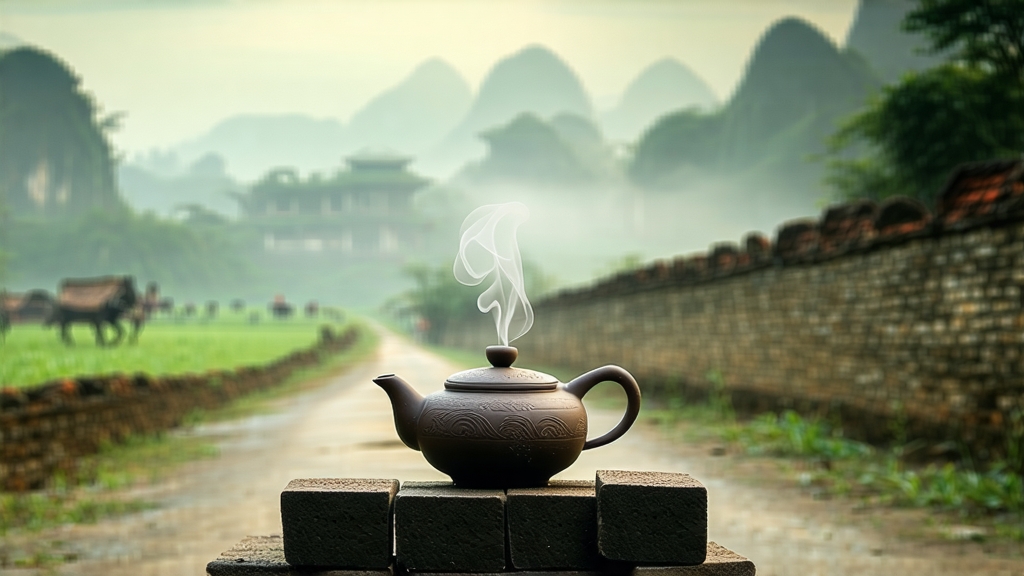
Liu Bao, literally “Six Forts,” is the name of a small market town in the humid, limestone hills of Guangxi Province, but it is also the name of one of China’s oldest fermented teas. While Pu-erh from Yunnan has conquered international menus, Liu Bao has remained a quiet insider’s secret, carried for centuries on the backs of mules and porters along the Tea-Horse Road that linked southern China with Indochina. Today the tea is experiencing a renaissance among Chinese collectors who prize its deep, camphor-betel fragrance and its uncanny ability to taste younger as it grows older. This article invites the global tea lover to discover Liu Bao’s history, craftsmanship, and the ritual language through which it speaks.
-
From Frontier Currency to Modern Treasure
The earliest written record appears in the 1567 edition of the Cangwu County Gazetteer: “The people of Liu Bao steam their tea in bamboo baskets, trading it for salt in Xunzhou.” By the Qing dynasty the tea had become a tax commodity; compressed bricks were accepted as military wages and shipped down the Xun River to Guangzhou for export to Malaysia and Singapore. In the tin mines of Kuala Lumpur, coolies drank it to dispel dampness and malaria; the colonial British noted that “the Chinese coolie’s dark tea smells of old leather but keeps him upright.” When tin prices collapsed in the 1930s the trade shrank, and Liu Bao retreated into provincial obscurity until the 2005 re-opening of the China-ASEAN trade corridor revived demand. Vintage baskets from the 1950s now fetch tens of thousands of dollars at auction in Guangzhou, outperforming many Pu-erh lots. -
The Micro-terroirs Within One Name
Although “Liu Bao” is a protected geographical indication, the tea is not monocultural. The core micro-region is the basin around the original six fort villages—Tongping, Xiangping, etc.—where red clay soil rich in iron and the subtropical monsoon create a natural humidity above 85 %. Leaves picked above 400 m carry higher geraniol, yielding orchid notes, whereas lower-elevation gardens give cineole-rich leaf that ages into camphor. Beyond the core zone, the broader Wuzhou prefecture produces “outer mountain” Liu Bao; these teas ferment faster but lack the cooling, throat-tingling kuwei that connoisseurs seek. Finally there are the “overseas returnees”—Malaysian stored baskets re-imported after 30 years in equatorial heat, their surface dusted with golden “golden flower” eurotium cristatum, a mold also celebrated in Fu brick tea. -
Craftsmanship: The Dance of Water, Heat, and Time
The processing calendar begins on the first day after Qingming when the mist lifts off the Qingshan ridge. Pickers take one bud with three or four leaves, slightly larger than the standard for green tea, because the thicker cell walls withstand the arduous piling to come. The leaves are immediately wilted under banana leaves for two hours, then wok-fried at 200 °C for no more than four minutes to arrest oxidation enzymes while preserving moisture for microbial life. What follows is unique: the hot leaves are thrown into a pine-fired oven called a lenglong, where they roll and tumble for ninety seconds, acquiring a light smokiness that later integrates into the aged bouquet. After rolling and a brief sun-drying, the maocha is ready for the defining step—wet piling. Workers spray 10 % humidity water over 500 kg heaps, cover them with jute sacks, and turn them every five days. Unlike the shorter 45-day Pu-erh wo dui, Liu Bao’s pile ferments for 60–70 days at 55 °C, encouraging the rise of Bacillus subtilis that converts proteins into sweet amino acids. Finally the tea is steamed, packed into 40 kg bamboo baskets lined with wild banana leaf, and left in an open warehouse where mountain breeze continues the slow oxidation for decades. -
The Language of the Basket
A Liu Bao basket is a time capsule. The tight weave allows 3 % airflow, enough for aerobic microbes but too little for mold sporulation. Over years the bundle contracts, developing a grey “silver frost” bloom that collectors examine with flashlights.